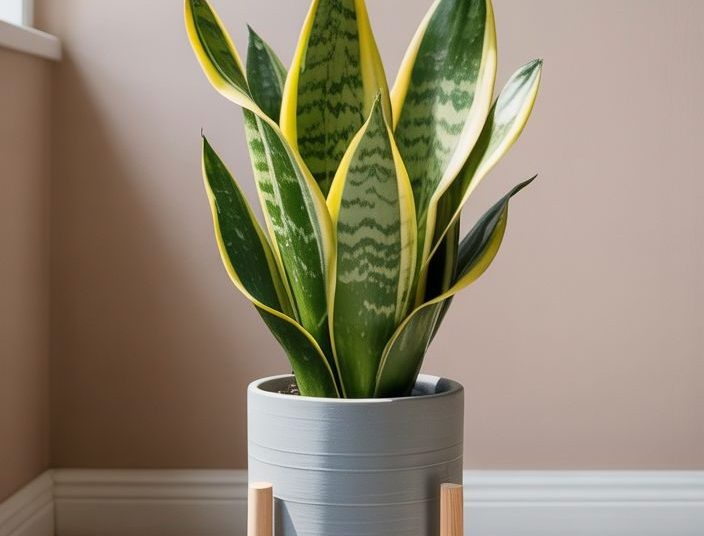Snake plants (Sansevieria), also called mother-in-law’s tongue, are beloved for their striking, upright leaves and low-maintenance nature. While they’re naturally slow growers, there are proven ways to give them a healthy boost and encourage faster, stronger growth. If you want your snake plant to thrive, here’s what you need to know.
8 tips to help snake plants grow faster
1. Provide the Right Amount of Light
Snake plants can survive in low light, but they grow faster when placed in bright, indirect sunlight. A spot near a sunny window with filtered light is ideal. Direct, harsh sun can scorch the leaves, while dim corners will slow growth.
Tip: Rotate the pot every few weeks so all sides of the plant receive light evenly.
2. Choose the Correct Soil
Well-draining soil is essential. Snake plants dislike soggy roots, which can lead to rot and stunted growth. A cactus or succulent mix works well, or you can make your own by mixing:
- 2 parts potting soil
- 1 part sand or perlite
- 1 part peat moss or coco coir
This combination ensures good airflow and proper drainage.
3. Water Wisely

Overwatering is the number one snake plant killer. To boost growth, follow the “soak and dry” method:
- Water deeply until it drains out of the pot.
- Let the soil dry completely before watering again.
- In summer, water every 2–3 weeks; in winter, once a month may be enough.
Always check the soil moisture with your finger before watering.
4. Use the Right Fertilizer
Feeding your snake plant gives it the nutrients needed for faster growth. Use a balanced liquid fertilizer (10-10-10) or a succulent fertilizer diluted to half strength. Fertilize only during the growing season (spring and summer) about once a month.
Avoid: Over-fertilizing, which can burn the roots.
5. Keep the Temperature and Humidity Stable
Snake plants thrive in warm, stable conditions.
- Ideal temperature: 65–85°F (18–29°C)
- Minimum temperature: 50°F (10°C)
They also tolerate low humidity but will grow faster in moderate humidity. Keep them away from drafts, air conditioners, or heaters.
6. Repot When Needed
Snake plants like being slightly root-bound, but if roots start circling the pot or breaking through, it’s time to repot. Moving your plant into a slightly larger container every 2–3 years gives the roots more space to grow, which speeds up leaf production.
7. Prune and Propagate
Cutting away damaged or old leaves allows the plant to direct energy into new growth. You can also propagate healthy leaf cuttings in soil or water to create new plants.
8. Keep Pests Away
Snake plants are fairly pest-resistant, but spider mites and mealybugs can slow growth. Inspect the leaves regularly and wipe them with a damp cloth. If pests appear, use neem oil or insecticidal soap.
Common Mistakes That Slow Snake Plant Growth
Even with the best intentions, some habits can hold your snake plant back. Here are a few mistakes to avoid:
- Overwatering: The most common reason for root rot and poor growth.
- Using the wrong soil: Heavy, compact soil suffocates roots and traps water.
- Too little light: Snake plants survive in low light, but they won’t thrive there.
- Ignoring rootbound plants: Leaving your plant in an overcrowded pot can restrict growth.
- Over-fertilizing: More fertilizer doesn’t mean more growth; it can damage roots instead.
Frequently Asked Questions (FAQ)
1. Why is my snake plant not growing?
Snake plants grow slowly by nature, but poor light, overwatering, heavy soil, or being rootbound can make them stop growing. Improving their environment usually boosts growth.
2. What fertilizer makes snake plants grow faster?
A balanced liquid fertilizer (10-10-10) or a succulent fertilizer diluted to half strength works best. Apply once a month during spring and summer only.
3. Do snake plants grow faster indoors or outdoors?
Snake plants generally grow faster outdoors in warm, indirect sunlight. Indoors, they will grow well too if placed near a bright window.
4. How long does it take for a snake plant to grow new leaves?
With proper care, new leaves can appear every few months during the growing season (spring and summer). Growth slows significantly in winter.
5. Can repotting make my snake plant grow faster?
Yes. Repotting every 2–3 years gives the roots more space and fresh soil, encouraging faster and healthier growth.
Final Thoughts
While snake plants will never grow as quickly as some other houseplants, following these steps ensures they grow faster, healthier, and stronger. With the right mix of light, water, soil, and care—plus avoiding common mistakes—your snake plant will reward you with lush, tall leaves that bring beauty and clean air to your home.
















